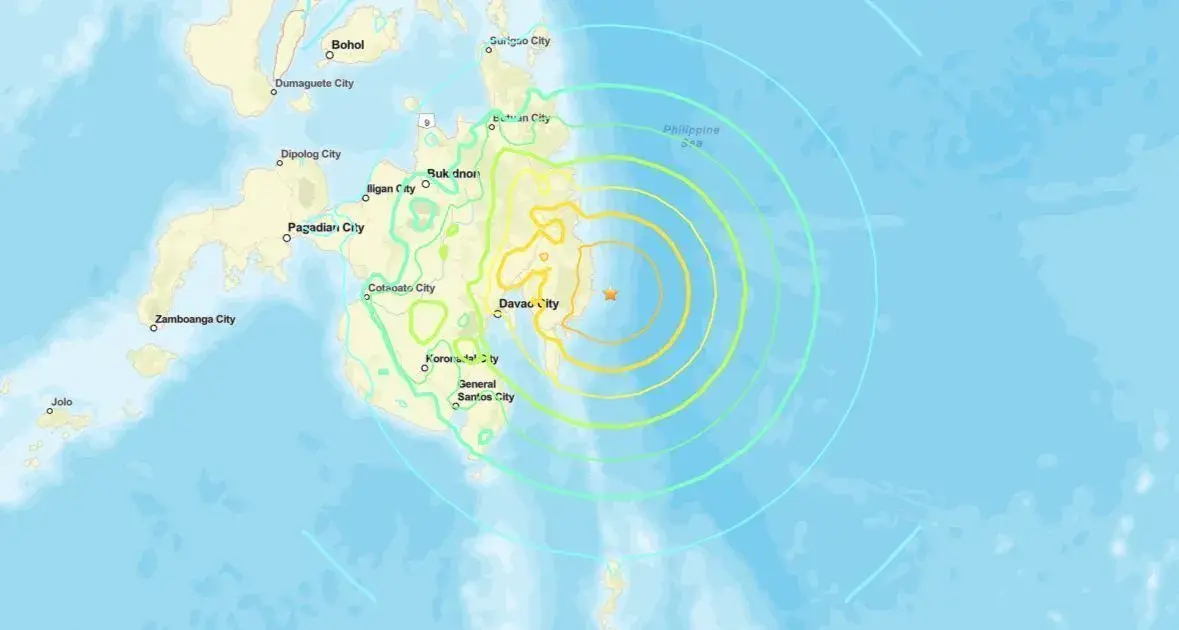
The Quakes: What We Know So Far 🔍
The first quake registered magnitude 7.4, centered off the coast of Manay, Davao Oriental at a depth of about 20 km. Reuters+2AP News+2
Hours later, a secondary quake of magnitude 6.8 (or 6.7 depending on reports) struck the same region, forming what seismologists call a “doublet” — two powerful tremors along the same fault zone. Wikipedia+3AP News+3Reuters+3
The Philippines’ seismic agencies also noted many aftershocks rolling through the area in subsequent hours and days. Wikipedia+3AP News+3The Guardian+3
Human Cost & Community Impact 🕯️
At least 7 people have died in the first quake and its aftermath — including individuals struck by falling debris, victims of landslides, and some who suffered fatal heart attacks amid the chaos. AP News+2The Guardian+2
Some victims were in hospitals at the time; others were in remote municipalities where landslides proved deadly. AP News+2People.com+2
Buildings, roads, and infrastructures in towns around Davao Oriental show visible cracks, damage, and signs of structural distress. Local schools and hospitals were among the facilities assessed or evacuated. AP News+2The Guardian+2
Coastal areas were under tsunami warnings in the aftermath, prompting evacuations even as waves stayed relatively small and warnings were later lifted. People.com+3Reuters+3AP News+3
Why It Matters: The Science & The Struggle 🌿
The Philippines is perched on the Pacific “Ring of Fire,” a zone where tectonic plates collide, making the country prone to frequent seismic activity. Wikipedia+5Reuters+5Reuters+5
This October event came shortly after a magnitude 6.9 earthquake in Cebu earlier in the month, which left dozens dead and many displaced. The Guardian+3Reuters+3Wikipedia+3
The October doublet quakes remind us how fault lines that lie mostly undersea or along trenches can slip, producing shocks that shake both land and lives. The Guardian+3Wikipedia+3Reuters+3
What Comes Next: Response & Hope 🤝
Rescue, relief, and assessment teams are working under difficult conditions to reach remote areas, support affected communities, and deliver aid.
Repairing infrastructure and evaluating building safety will be a long process — from bridges to homes to schools.
Survivors and families will need emotional, medical, and material support in many places where access is limited.
Emergency plans may be revisited, early warning systems strengthened, and disaster preparedness renewed in light of the fresh shock.
A Gentle Reflection 🕊️
In moments like this, statistics and magnitudes seem cold beside real human suffering — mothers searching for loved ones, children shaken by fear, communities with scars invisible and visible.
The quakes serve as a reminder: nature is indifferent to borders, plans, or schedules. But our response — of compassion, resilience, and solidarity — is deeply human.

Leave a comment
Your email address will not be published. Required fields are marked *